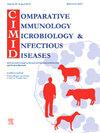印度中部和南部地区家禽的抗菌药耐药性概况正在发生变化,并呈现出明显的特征。
IF 2
3区 农林科学
Q4 IMMUNOLOGY
Comparative Immunology Microbiology and Infectious Diseases
Pub Date : 2024-10-16
DOI:10.1016/j.cimid.2024.102255
引用次数: 0
摘要
抗菌素耐药性(AMR)正在迅速出现,并正在耗尽抗生素资源。家禽是产生 AMR 的一个主要来源,因为现代生产方式广泛使用抗生素来提高产量。印度和中国是肉类的主要生产国,也是 AMR 的热点地区。据预测,印度中部和南部是家禽中新出现的 AMR 热点地区,但没有数据可以证实这一点。为此,我们从这些地区的家禽养殖场收集鸡粪便,并分离出基因组 DNA。此外,我们还进行了枪式全基因组测序,以进行元基因组学分析。我们首次报告了喀拉拉邦和特伦甘纳邦家禽的 AMR 基因图谱。样本中的革兰氏阴性菌和厌氧菌感染率较高。在印度检测到了大肠杆菌、产气荚膜梭菌、肺炎克雷伯氏菌、金黄色葡萄球菌、粪肠球菌、铜绿假单胞菌、脆弱拟杆菌等高度优先病原体。很明显,印度南部地区的 AMR 基因含量高于印度中部地区。印度最南端地区的大肠杆菌明显多于其他地区。我们的数据具有欧盟(EU)家禽养殖场的许多共同 AMR 特征,但缺少 mcr-1,而 mcr-1 是大肠杆菌中最近出现的 AMR 基因。我们的数据揭示了印度中部和南部的 AMR 基因进化程度。它与欧盟的数据相当,但严重程度低于欧盟。本文章由计算机程序翻译,如有差异,请以英文原文为准。
The antimicrobial resistance profile in poultry of Central and Southern India is evolving with distinct features
Antimicrobial resistance (AMR) is fast emerging and is depleting antibiotics repertoire. Poultry is a major source for AMR because focus to enhance its production by modern practices widely uses antibiotics. India and China are major producers of meat and have hotspots of AMR. The Central and Southern India were predicted as emerging hotspots for AMR in poultry but no data available to substantiate it. To this end, we collected chicken feces from poultry farms in these regions and isolated genomic DNA. Further, shotgun whole genome sequencing was performed for metagenomics analysis. For the first time, we report the AMR gene profiles in poultry from Kerala and Telangana. The samples exhibited a higher prevalence of gram-negative and anaerobic species. The high priority pathogens in India were detected, like E.coli, Clostridium perfringens, Klebsiella pneumonia Staphylococcus aureus, Enterococcous faecalis, Pseudomonas aeruginosa, Bacteriodes fragiles. Conspicuously, the Southern India had the highest abundance of AMR genes than the Central India. E.coli was significantly more prevalent in the southernmost zone of India than in other sites. Our data had many common AMR profile features of the European Union (EU) poultry farms but lacked mcr-1, which was a lately emerged AMR gene in E.coli. Our data revealed the extent of AMR gene evolved in the Central and Southern India. It is comparable to the EU data but severity is lesser than in the EU.
求助全文
通过发布文献求助,成功后即可免费获取论文全文。
去求助
来源期刊
CiteScore
4.60
自引率
0.00%
发文量
102
审稿时长
40 days
期刊介绍:
Comparative Immunology, Microbiology & Infectious Diseases aims to respond to the concept of "One Medicine" and to provide a venue for scientific exchange. Based on the concept of "Comparative Medicine" interdisciplinary cooperation between specialists in human and animal medicine is of mutual interest and benefit. Therefore, there is need to combine the respective interest of physicians, veterinarians and other health professionals for comparative studies relevant to either human or animal medicine .
The journal is open to subjects of common interest related to the immunology, immunopathology, microbiology, parasitology and epidemiology of human and animal infectious diseases, especially zoonotic infections, and animal models of human infectious diseases. The role of environmental factors in disease emergence is emphasized. CIMID is mainly focusing on applied veterinary and human medicine rather than on fundamental experimental research.

 求助内容:
求助内容: 应助结果提醒方式:
应助结果提醒方式:


